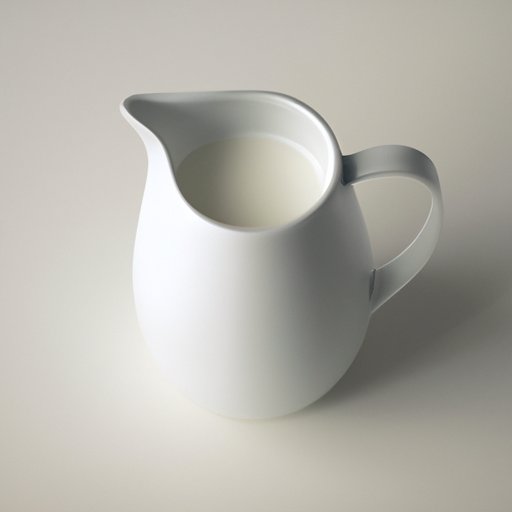
Introduction
If you’ve ever found yourself in the middle of a recipe, only to realize you’re out of heavy cream, you may be wondering if you can substitute milk in its place. While it’s not always a straightforward swap, there are ways to make it work without compromising on taste or texture.
This article will explore the differences between milk and heavy cream, offer tips and tricks for baking and cooking with milk instead of cream, and present delicious recipes to try. By the end, you’ll have a better understanding of when and how to use milk as a substitute for heavy cream in your culinary adventures.

Dairy 101: Understanding the Differences Between Milk and Heavy Cream
Milk is a staple ingredient in many dishes, from oatmeal to mac and cheese. It’s a liquid dairy product that comes in many variations, including whole, 2%, 1%, and skim. Milk contains a range of vitamins and minerals, including calcium, vitamin D, and potassium.
Heavy cream, also known as whipping cream, is a thicker, richer dairy product with a fat content of at least 36%. It’s often used in baking, cooking, and as a topping for desserts. Heavy cream has a more velvety texture and a richer taste than milk, which is why it’s used in so many decadent recipes.
The main difference between milk and heavy cream is their fat content. Milk typically has a fat content of around 4%, which is much lower than heavy cream. Heavy cream is also much thicker than milk, which can impact the overall texture of a dish.
10 Delicious Recipes that Replace Heavy Cream with Milk
If you’re looking to substitute milk for heavy cream in your favorite recipes, there are plenty of options that will still result in a delicious dish. Here are ten recipes to get you started:
- Chicken and Broccoli Alfredo: Swap out the heavy cream in this classic pasta dish for whole milk and a bit of flour to thicken the sauce.
- Potato Soup: Instead of using heavy cream in this comforting soup, blend together potatoes, milk, and a bit of sour cream for a creamy texture.
- Quiche: Use a mixture of eggs, milk, and grated cheese to replace heavy cream in this brunch favorite.
- Banana Cream Pie: Make a custard filling with cornstarch, sugar, vanilla, and milk for a lighter take on this classic dessert.
- Cheddar Cheese Sauce: Whisk together milk, flour, and grated cheddar cheese for a tangy, creamy sauce to smother on vegetables or pasta.
- Creamed Spinach: Sauté spinach, garlic, and onions, then add a mixture of milk and cream cheese for a decadent side dish.
- Macaroni and Cheese: Instead of using heavy cream, make a roux with butter and flour, then whisk in milk and shredded cheese for a classic mac and cheese recipe.
- Chicken Pot Pie: Use milk and flour to make a roux, then add chicken broth to create a savory, creamy gravy for this comforting dish.
- Creamy Salad Dressings: Replace heavy cream with milk and mayonnaise in recipes for ranch, blue cheese, or Caesar dressings.
- Scalloped Potatoes: Thinly slice potatoes and layer with milk, grated cheese, and seasonings to create a creamy, cheesy casserole dish.
Baking Hacks: How to Substitute Milk for Heavy Cream in Your Favorite Desserts
When it comes to baking, substituting milk for heavy cream can be a bit trickier. Heavy cream adds richness and moisture to desserts, which can affect the overall texture and flavor of your baked goods.
However, with a bit of experimentation and some helpful tips, you can successfully use milk instead of heavy cream in many desserts. Here are some suggestions:
- Use whole milk or a combination of milk and melted butter to replace heavy cream in recipes for cake or cupcakes.
- In recipes that call for heavy cream to make a ganache, use a mixture of milk and semi-sweet chocolate chips instead.
- For custard-based desserts like flan or crème brûlée, use a mixture of milk and cornstarch to replace heavy cream.
- In pie recipes that use heavy cream, try blending silken tofu with milk and corn syrup to create a creamy filling.
- In recipes that call for whipped cream, use chilled evaporated milk that’s been whipped with sugar instead.
Cooking Creamy Soups without Heavy Cream: Milk Substitutes to Try
Creamy soups are comforting and delicious, but they often call for heavy cream, which can increase the calorie count significantly. Here are some alternative ingredients to use instead of heavy cream:
- Coconut Milk: This dairy-free option adds richness and creaminess to soups and stews, and has a slightly sweet, tropical taste.
- Buttermilk: Use buttermilk to add tanginess and creaminess to creamy soups while also reducing the fat content.
- Yogurt: Use Greek yogurt or sour cream to thicken and add creaminess to soups, while also adding protein.
- Broth: For a lighter option, use vegetable or chicken broth to create a flavorful base for your soup.
Healthy Swaps: Using Milk as a Substitute for Heavy Cream in Savory Dishes
Using milk instead of heavy cream in savory dishes can be a smart way to reduce the calorie and fat content. Here are some ideas for swaps to try:
- Use skim milk instead of heavy cream in recipes for creamy pasta dishes like fettuccine Alfredo.
- Use a mixture of low-fat milk and cornstarch to replace heavy cream in recipes for creamy soups and casseroles.
- For a lighter version of mashed potatoes, mash boiled potatoes with a bit of milk and Greek yogurt instead of heavy cream and butter.
- In recipes for creamed vegetables like spinach or peas, use a mixture of milk and onion puree instead of heavy cream.
The Pros and Cons of Substituting Milk for Heavy Cream in Your Cooking and Baking
While there are many reasons to use milk instead of heavy cream in your cooking and baking, there are also some drawbacks to consider. Here are the pros and cons:
Pros
- Milk is lower in fat and calories than heavy cream.
- Milk is a staple ingredient in most households, so you’re less likely to need to make a special trip to the store for heavy cream.
- Using milk can create a lighter, less heavy feeling in dishes that can be weighed down by heavy cream.
Cons
- Heavy cream adds richness and depth of flavor that can be difficult to replicate with milk.
- Heavy cream creates a thicker, more velvety texture that isn’t always achievable with milk.
- Some dishes that traditionally call for heavy cream may not work as well with milk, such as certain desserts or sauces that require the extra fat content.
Conclusion
While substituting milk for heavy cream isn’t always a straightforward swap, it’s definitely possible to create delicious dishes and desserts without heavy cream. By understanding the differences between milk and heavy cream, experimenting with recipes and ingredients, and using some of the tips and substitutions outlined in this article, you can successfully use milk in many dishes that traditionally call for heavy cream.
So go ahead and give it a try! You may be surprised by the results.




